Purchasing Management: Supplier Selection and ICT at BHP Billiton
VerifiedAdded on 2020/04/07
|11
|2967
|210
Report
AI Summary
This report offers a comprehensive analysis of purchasing management practices within BHP Billiton, a multinational mining company. It begins by outlining the company's products, supplier markets, competitors, and organizational goals. The core of the report delves into supplier selection criteria, emphasizing the shift from reactive to proactive buying and the importance of establishing evaluation criteria. It then explores BHP Billiton's purchasing goals, including developing discount strategies, enhancing quality, and reducing inventory costs. The report details the appropriate criteria for selecting suppliers, such as identifying suppliers, measuring performance, and achieving certifications. Furthermore, it examines the application of Information and Communication Technology (ICT) in purchasing operations, highlighting tools like Material Resource Planning (MRP) and Distribution Requirements Planning (DRP) to improve efficiency. Finally, the report analyzes purchasing cost analysis, recommending tools like cost analysis, inventory analysis, and maverick spending analysis to optimize the purchasing process and maximize revenue. The report emphasizes the importance of these elements in achieving BHP Billiton's purchasing goals and maintaining a competitive edge.
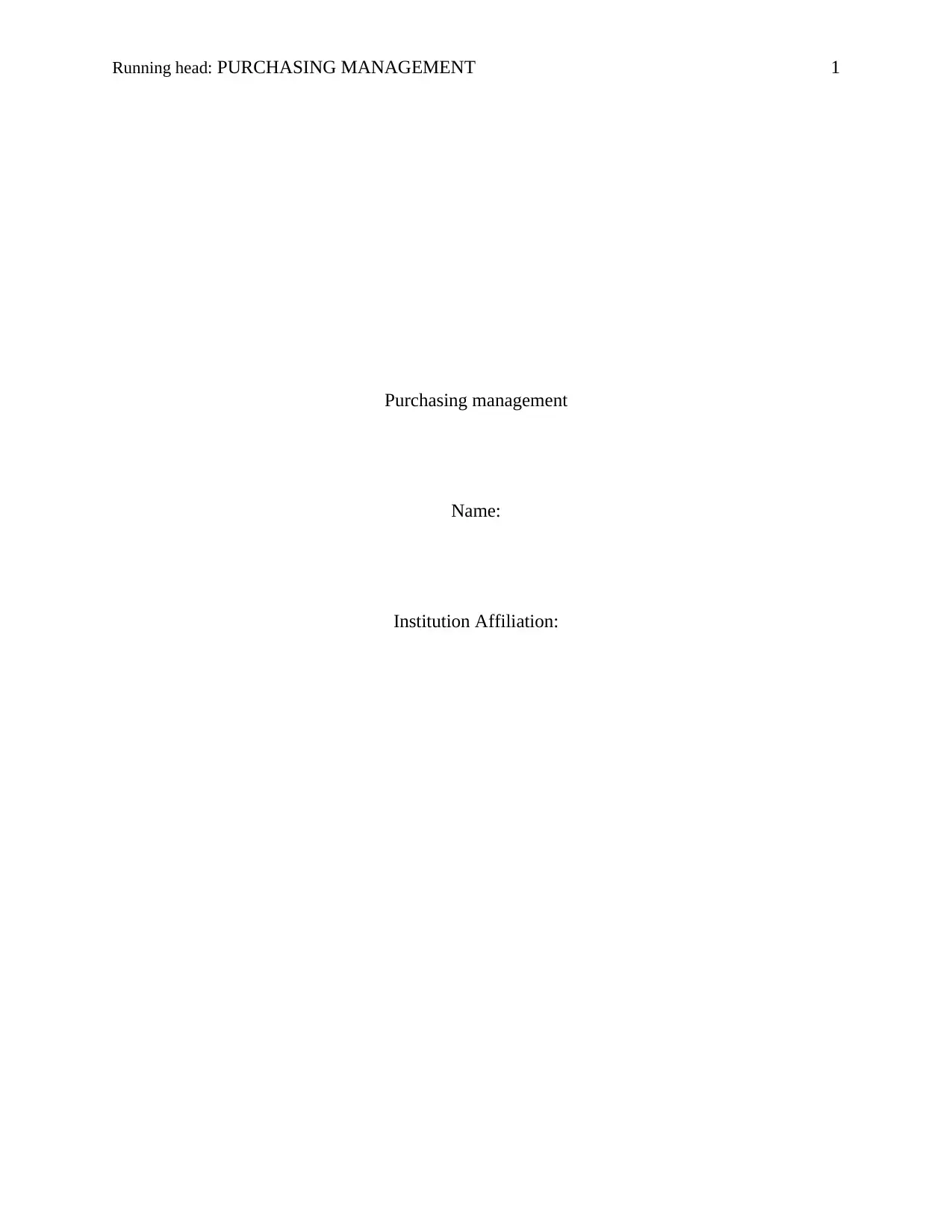
Running head: PURCHASING MANAGEMENT 1
Purchasing management
Name:
Institution Affiliation:
Purchasing management
Name:
Institution Affiliation:
Paraphrase This Document
Need a fresh take? Get an instant paraphrase of this document with our AI Paraphraser
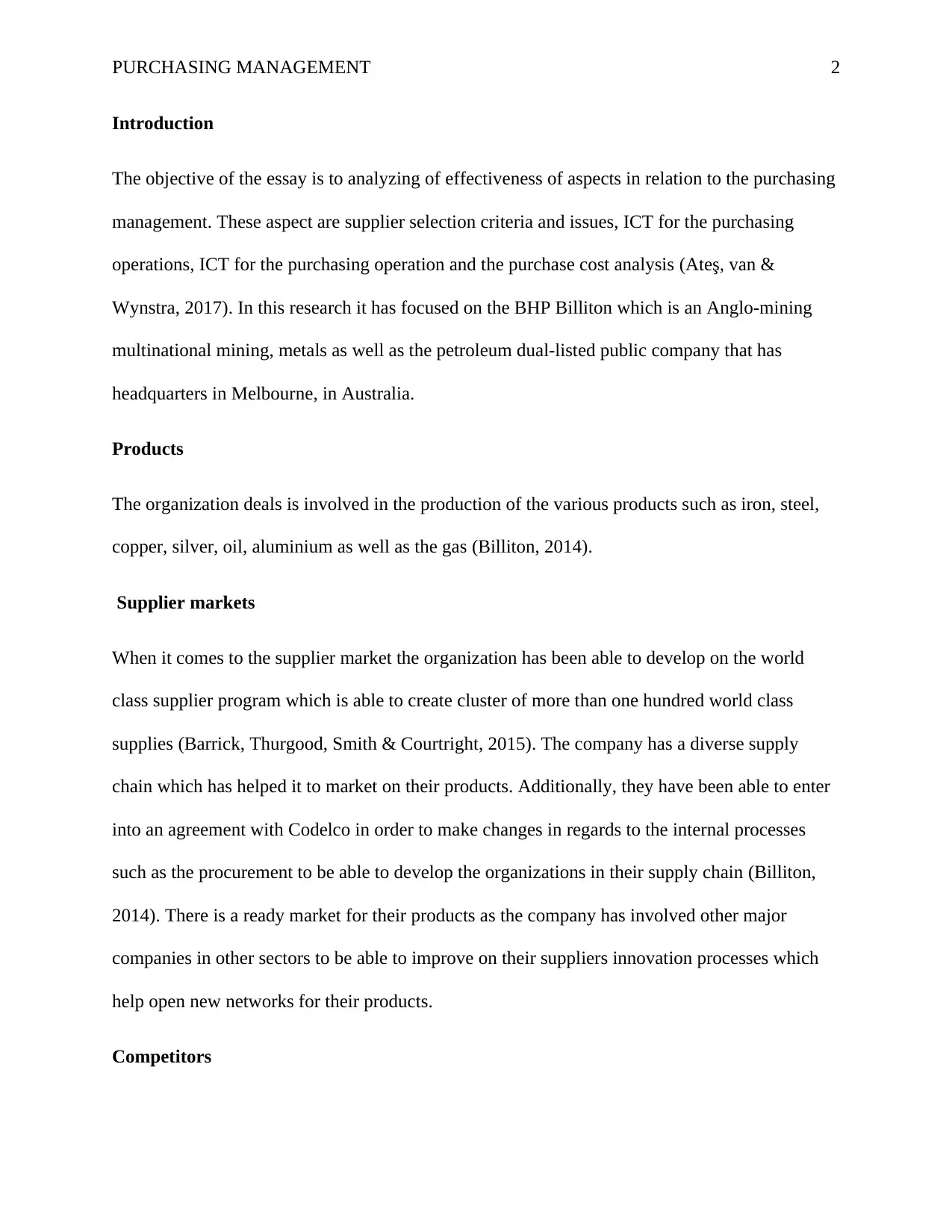
PURCHASING MANAGEMENT 2
Introduction
The objective of the essay is to analyzing of effectiveness of aspects in relation to the purchasing
management. These aspect are supplier selection criteria and issues, ICT for the purchasing
operations, ICT for the purchasing operation and the purchase cost analysis (Ateş, van &
Wynstra, 2017). In this research it has focused on the BHP Billiton which is an Anglo-mining
multinational mining, metals as well as the petroleum dual-listed public company that has
headquarters in Melbourne, in Australia.
Products
The organization deals is involved in the production of the various products such as iron, steel,
copper, silver, oil, aluminium as well as the gas (Billiton, 2014).
Supplier markets
When it comes to the supplier market the organization has been able to develop on the world
class supplier program which is able to create cluster of more than one hundred world class
supplies (Barrick, Thurgood, Smith & Courtright, 2015). The company has a diverse supply
chain which has helped it to market on their products. Additionally, they have been able to enter
into an agreement with Codelco in order to make changes in regards to the internal processes
such as the procurement to be able to develop the organizations in their supply chain (Billiton,
2014). There is a ready market for their products as the company has involved other major
companies in other sectors to be able to improve on their suppliers innovation processes which
help open new networks for their products.
Competitors
Introduction
The objective of the essay is to analyzing of effectiveness of aspects in relation to the purchasing
management. These aspect are supplier selection criteria and issues, ICT for the purchasing
operations, ICT for the purchasing operation and the purchase cost analysis (Ateş, van &
Wynstra, 2017). In this research it has focused on the BHP Billiton which is an Anglo-mining
multinational mining, metals as well as the petroleum dual-listed public company that has
headquarters in Melbourne, in Australia.
Products
The organization deals is involved in the production of the various products such as iron, steel,
copper, silver, oil, aluminium as well as the gas (Billiton, 2014).
Supplier markets
When it comes to the supplier market the organization has been able to develop on the world
class supplier program which is able to create cluster of more than one hundred world class
supplies (Barrick, Thurgood, Smith & Courtright, 2015). The company has a diverse supply
chain which has helped it to market on their products. Additionally, they have been able to enter
into an agreement with Codelco in order to make changes in regards to the internal processes
such as the procurement to be able to develop the organizations in their supply chain (Billiton,
2014). There is a ready market for their products as the company has involved other major
companies in other sectors to be able to improve on their suppliers innovation processes which
help open new networks for their products.
Competitors
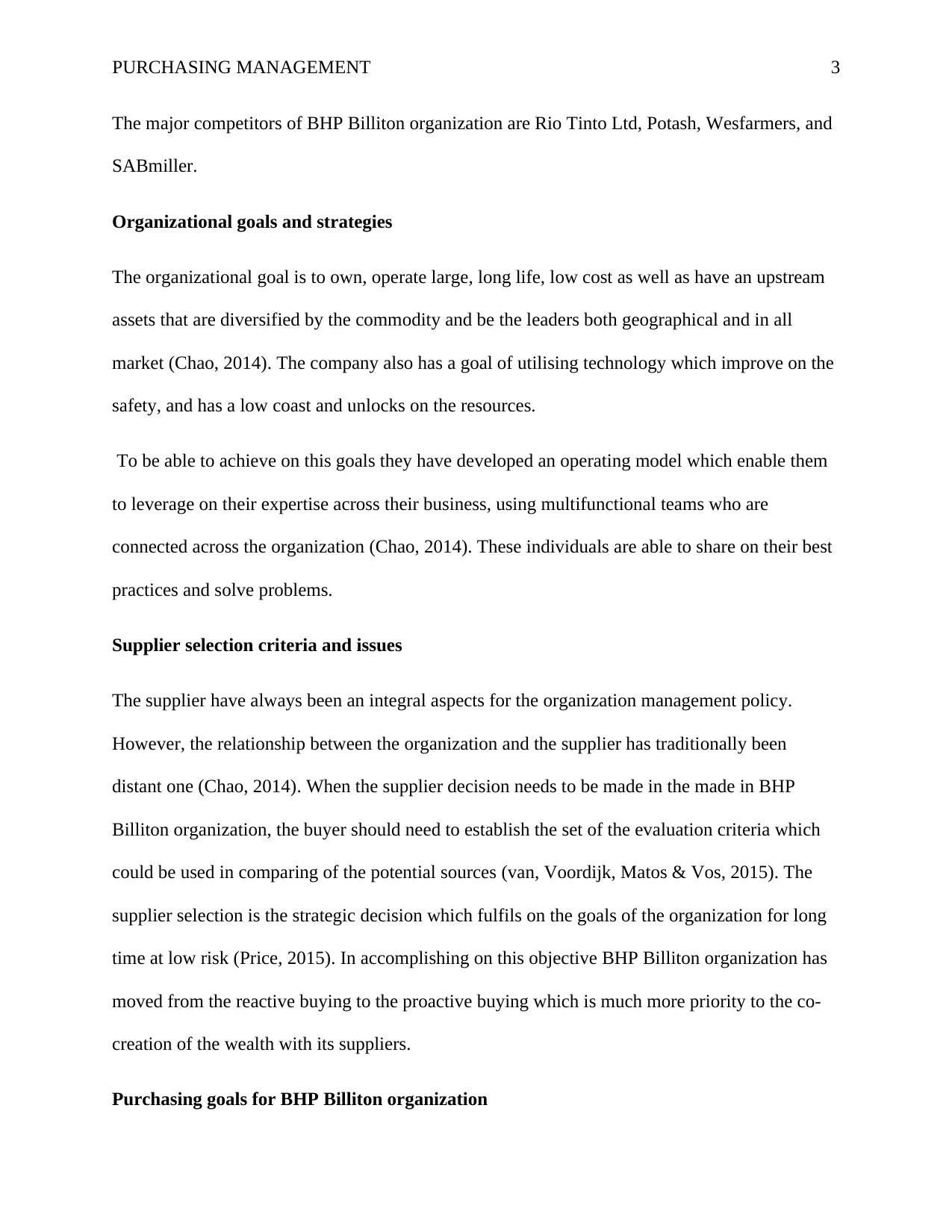
PURCHASING MANAGEMENT 3
The major competitors of BHP Billiton organization are Rio Tinto Ltd, Potash, Wesfarmers, and
SABmiller.
Organizational goals and strategies
The organizational goal is to own, operate large, long life, low cost as well as have an upstream
assets that are diversified by the commodity and be the leaders both geographical and in all
market (Chao, 2014). The company also has a goal of utilising technology which improve on the
safety, and has a low coast and unlocks on the resources.
To be able to achieve on this goals they have developed an operating model which enable them
to leverage on their expertise across their business, using multifunctional teams who are
connected across the organization (Chao, 2014). These individuals are able to share on their best
practices and solve problems.
Supplier selection criteria and issues
The supplier have always been an integral aspects for the organization management policy.
However, the relationship between the organization and the supplier has traditionally been
distant one (Chao, 2014). When the supplier decision needs to be made in the made in BHP
Billiton organization, the buyer should need to establish the set of the evaluation criteria which
could be used in comparing of the potential sources (van, Voordijk, Matos & Vos, 2015). The
supplier selection is the strategic decision which fulfils on the goals of the organization for long
time at low risk (Price, 2015). In accomplishing on this objective BHP Billiton organization has
moved from the reactive buying to the proactive buying which is much more priority to the co-
creation of the wealth with its suppliers.
Purchasing goals for BHP Billiton organization
The major competitors of BHP Billiton organization are Rio Tinto Ltd, Potash, Wesfarmers, and
SABmiller.
Organizational goals and strategies
The organizational goal is to own, operate large, long life, low cost as well as have an upstream
assets that are diversified by the commodity and be the leaders both geographical and in all
market (Chao, 2014). The company also has a goal of utilising technology which improve on the
safety, and has a low coast and unlocks on the resources.
To be able to achieve on this goals they have developed an operating model which enable them
to leverage on their expertise across their business, using multifunctional teams who are
connected across the organization (Chao, 2014). These individuals are able to share on their best
practices and solve problems.
Supplier selection criteria and issues
The supplier have always been an integral aspects for the organization management policy.
However, the relationship between the organization and the supplier has traditionally been
distant one (Chao, 2014). When the supplier decision needs to be made in the made in BHP
Billiton organization, the buyer should need to establish the set of the evaluation criteria which
could be used in comparing of the potential sources (van, Voordijk, Matos & Vos, 2015). The
supplier selection is the strategic decision which fulfils on the goals of the organization for long
time at low risk (Price, 2015). In accomplishing on this objective BHP Billiton organization has
moved from the reactive buying to the proactive buying which is much more priority to the co-
creation of the wealth with its suppliers.
Purchasing goals for BHP Billiton organization
⊘ This is a preview!⊘
Do you want full access?
Subscribe today to unlock all pages.

Trusted by 1+ million students worldwide
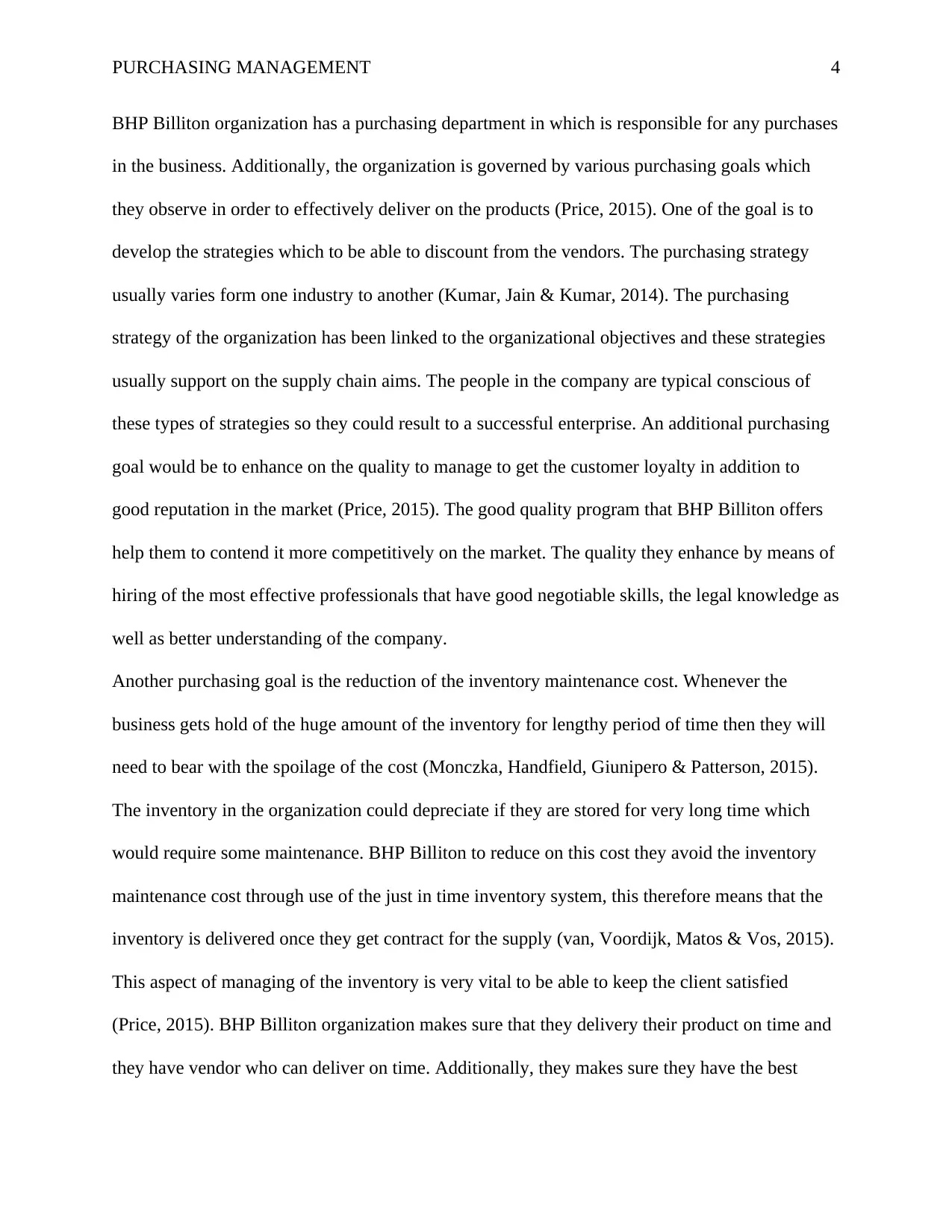
PURCHASING MANAGEMENT 4
BHP Billiton organization has a purchasing department in which is responsible for any purchases
in the business. Additionally, the organization is governed by various purchasing goals which
they observe in order to effectively deliver on the products (Price, 2015). One of the goal is to
develop the strategies which to be able to discount from the vendors. The purchasing strategy
usually varies form one industry to another (Kumar, Jain & Kumar, 2014). The purchasing
strategy of the organization has been linked to the organizational objectives and these strategies
usually support on the supply chain aims. The people in the company are typical conscious of
these types of strategies so they could result to a successful enterprise. An additional purchasing
goal would be to enhance on the quality to manage to get the customer loyalty in addition to
good reputation in the market (Price, 2015). The good quality program that BHP Billiton offers
help them to contend it more competitively on the market. The quality they enhance by means of
hiring of the most effective professionals that have good negotiable skills, the legal knowledge as
well as better understanding of the company.
Another purchasing goal is the reduction of the inventory maintenance cost. Whenever the
business gets hold of the huge amount of the inventory for lengthy period of time then they will
need to bear with the spoilage of the cost (Monczka, Handfield, Giunipero & Patterson, 2015).
The inventory in the organization could depreciate if they are stored for very long time which
would require some maintenance. BHP Billiton to reduce on this cost they avoid the inventory
maintenance cost through use of the just in time inventory system, this therefore means that the
inventory is delivered once they get contract for the supply (van, Voordijk, Matos & Vos, 2015).
This aspect of managing of the inventory is very vital to be able to keep the client satisfied
(Price, 2015). BHP Billiton organization makes sure that they delivery their product on time and
they have vendor who can deliver on time. Additionally, they makes sure they have the best
BHP Billiton organization has a purchasing department in which is responsible for any purchases
in the business. Additionally, the organization is governed by various purchasing goals which
they observe in order to effectively deliver on the products (Price, 2015). One of the goal is to
develop the strategies which to be able to discount from the vendors. The purchasing strategy
usually varies form one industry to another (Kumar, Jain & Kumar, 2014). The purchasing
strategy of the organization has been linked to the organizational objectives and these strategies
usually support on the supply chain aims. The people in the company are typical conscious of
these types of strategies so they could result to a successful enterprise. An additional purchasing
goal would be to enhance on the quality to manage to get the customer loyalty in addition to
good reputation in the market (Price, 2015). The good quality program that BHP Billiton offers
help them to contend it more competitively on the market. The quality they enhance by means of
hiring of the most effective professionals that have good negotiable skills, the legal knowledge as
well as better understanding of the company.
Another purchasing goal is the reduction of the inventory maintenance cost. Whenever the
business gets hold of the huge amount of the inventory for lengthy period of time then they will
need to bear with the spoilage of the cost (Monczka, Handfield, Giunipero & Patterson, 2015).
The inventory in the organization could depreciate if they are stored for very long time which
would require some maintenance. BHP Billiton to reduce on this cost they avoid the inventory
maintenance cost through use of the just in time inventory system, this therefore means that the
inventory is delivered once they get contract for the supply (van, Voordijk, Matos & Vos, 2015).
This aspect of managing of the inventory is very vital to be able to keep the client satisfied
(Price, 2015). BHP Billiton organization makes sure that they delivery their product on time and
they have vendor who can deliver on time. Additionally, they makes sure they have the best
Paraphrase This Document
Need a fresh take? Get an instant paraphrase of this document with our AI Paraphraser
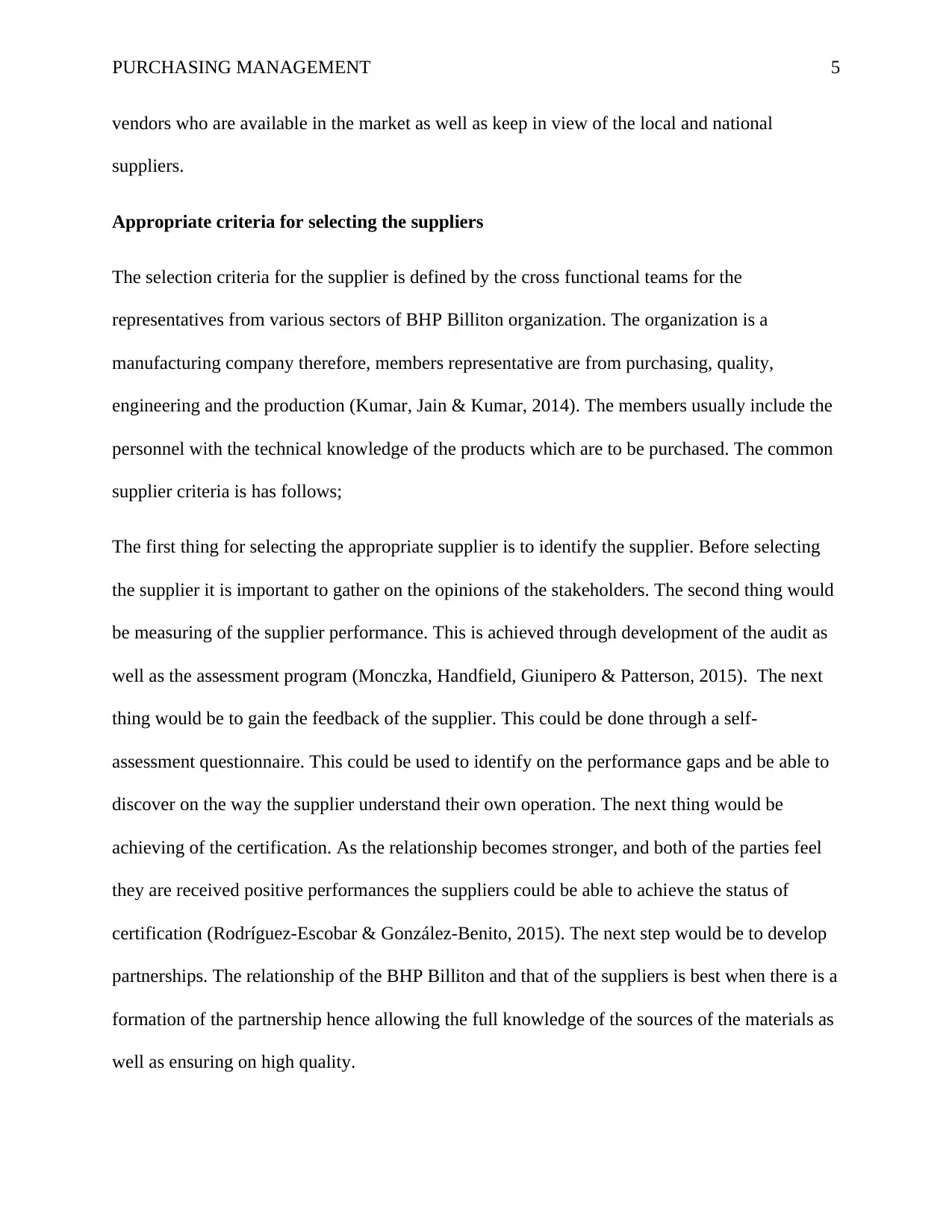
PURCHASING MANAGEMENT 5
vendors who are available in the market as well as keep in view of the local and national
suppliers.
Appropriate criteria for selecting the suppliers
The selection criteria for the supplier is defined by the cross functional teams for the
representatives from various sectors of BHP Billiton organization. The organization is a
manufacturing company therefore, members representative are from purchasing, quality,
engineering and the production (Kumar, Jain & Kumar, 2014). The members usually include the
personnel with the technical knowledge of the products which are to be purchased. The common
supplier criteria is has follows;
The first thing for selecting the appropriate supplier is to identify the supplier. Before selecting
the supplier it is important to gather on the opinions of the stakeholders. The second thing would
be measuring of the supplier performance. This is achieved through development of the audit as
well as the assessment program (Monczka, Handfield, Giunipero & Patterson, 2015). The next
thing would be to gain the feedback of the supplier. This could be done through a self-
assessment questionnaire. This could be used to identify on the performance gaps and be able to
discover on the way the supplier understand their own operation. The next thing would be
achieving of the certification. As the relationship becomes stronger, and both of the parties feel
they are received positive performances the suppliers could be able to achieve the status of
certification (Rodríguez-Escobar & González-Benito, 2015). The next step would be to develop
partnerships. The relationship of the BHP Billiton and that of the suppliers is best when there is a
formation of the partnership hence allowing the full knowledge of the sources of the materials as
well as ensuring on high quality.
vendors who are available in the market as well as keep in view of the local and national
suppliers.
Appropriate criteria for selecting the suppliers
The selection criteria for the supplier is defined by the cross functional teams for the
representatives from various sectors of BHP Billiton organization. The organization is a
manufacturing company therefore, members representative are from purchasing, quality,
engineering and the production (Kumar, Jain & Kumar, 2014). The members usually include the
personnel with the technical knowledge of the products which are to be purchased. The common
supplier criteria is has follows;
The first thing for selecting the appropriate supplier is to identify the supplier. Before selecting
the supplier it is important to gather on the opinions of the stakeholders. The second thing would
be measuring of the supplier performance. This is achieved through development of the audit as
well as the assessment program (Monczka, Handfield, Giunipero & Patterson, 2015). The next
thing would be to gain the feedback of the supplier. This could be done through a self-
assessment questionnaire. This could be used to identify on the performance gaps and be able to
discover on the way the supplier understand their own operation. The next thing would be
achieving of the certification. As the relationship becomes stronger, and both of the parties feel
they are received positive performances the suppliers could be able to achieve the status of
certification (Rodríguez-Escobar & González-Benito, 2015). The next step would be to develop
partnerships. The relationship of the BHP Billiton and that of the suppliers is best when there is a
formation of the partnership hence allowing the full knowledge of the sources of the materials as
well as ensuring on high quality.
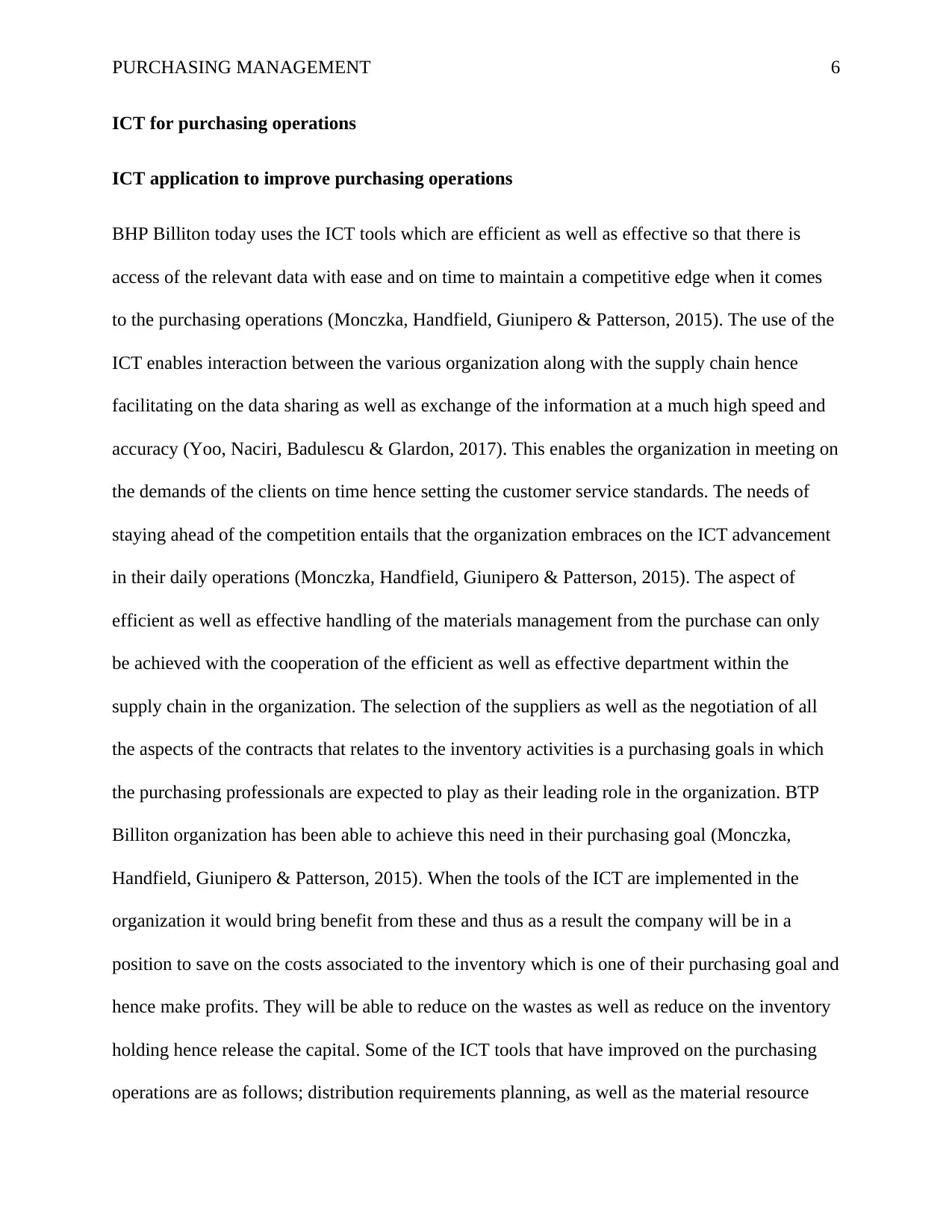
PURCHASING MANAGEMENT 6
ICT for purchasing operations
ICT application to improve purchasing operations
BHP Billiton today uses the ICT tools which are efficient as well as effective so that there is
access of the relevant data with ease and on time to maintain a competitive edge when it comes
to the purchasing operations (Monczka, Handfield, Giunipero & Patterson, 2015). The use of the
ICT enables interaction between the various organization along with the supply chain hence
facilitating on the data sharing as well as exchange of the information at a much high speed and
accuracy (Yoo, Naciri, Badulescu & Glardon, 2017). This enables the organization in meeting on
the demands of the clients on time hence setting the customer service standards. The needs of
staying ahead of the competition entails that the organization embraces on the ICT advancement
in their daily operations (Monczka, Handfield, Giunipero & Patterson, 2015). The aspect of
efficient as well as effective handling of the materials management from the purchase can only
be achieved with the cooperation of the efficient as well as effective department within the
supply chain in the organization. The selection of the suppliers as well as the negotiation of all
the aspects of the contracts that relates to the inventory activities is a purchasing goals in which
the purchasing professionals are expected to play as their leading role in the organization. BTP
Billiton organization has been able to achieve this need in their purchasing goal (Monczka,
Handfield, Giunipero & Patterson, 2015). When the tools of the ICT are implemented in the
organization it would bring benefit from these and thus as a result the company will be in a
position to save on the costs associated to the inventory which is one of their purchasing goal and
hence make profits. They will be able to reduce on the wastes as well as reduce on the inventory
holding hence release the capital. Some of the ICT tools that have improved on the purchasing
operations are as follows; distribution requirements planning, as well as the material resource
ICT for purchasing operations
ICT application to improve purchasing operations
BHP Billiton today uses the ICT tools which are efficient as well as effective so that there is
access of the relevant data with ease and on time to maintain a competitive edge when it comes
to the purchasing operations (Monczka, Handfield, Giunipero & Patterson, 2015). The use of the
ICT enables interaction between the various organization along with the supply chain hence
facilitating on the data sharing as well as exchange of the information at a much high speed and
accuracy (Yoo, Naciri, Badulescu & Glardon, 2017). This enables the organization in meeting on
the demands of the clients on time hence setting the customer service standards. The needs of
staying ahead of the competition entails that the organization embraces on the ICT advancement
in their daily operations (Monczka, Handfield, Giunipero & Patterson, 2015). The aspect of
efficient as well as effective handling of the materials management from the purchase can only
be achieved with the cooperation of the efficient as well as effective department within the
supply chain in the organization. The selection of the suppliers as well as the negotiation of all
the aspects of the contracts that relates to the inventory activities is a purchasing goals in which
the purchasing professionals are expected to play as their leading role in the organization. BTP
Billiton organization has been able to achieve this need in their purchasing goal (Monczka,
Handfield, Giunipero & Patterson, 2015). When the tools of the ICT are implemented in the
organization it would bring benefit from these and thus as a result the company will be in a
position to save on the costs associated to the inventory which is one of their purchasing goal and
hence make profits. They will be able to reduce on the wastes as well as reduce on the inventory
holding hence release the capital. Some of the ICT tools that have improved on the purchasing
operations are as follows; distribution requirements planning, as well as the material resource
⊘ This is a preview!⊘
Do you want full access?
Subscribe today to unlock all pages.

Trusted by 1+ million students worldwide
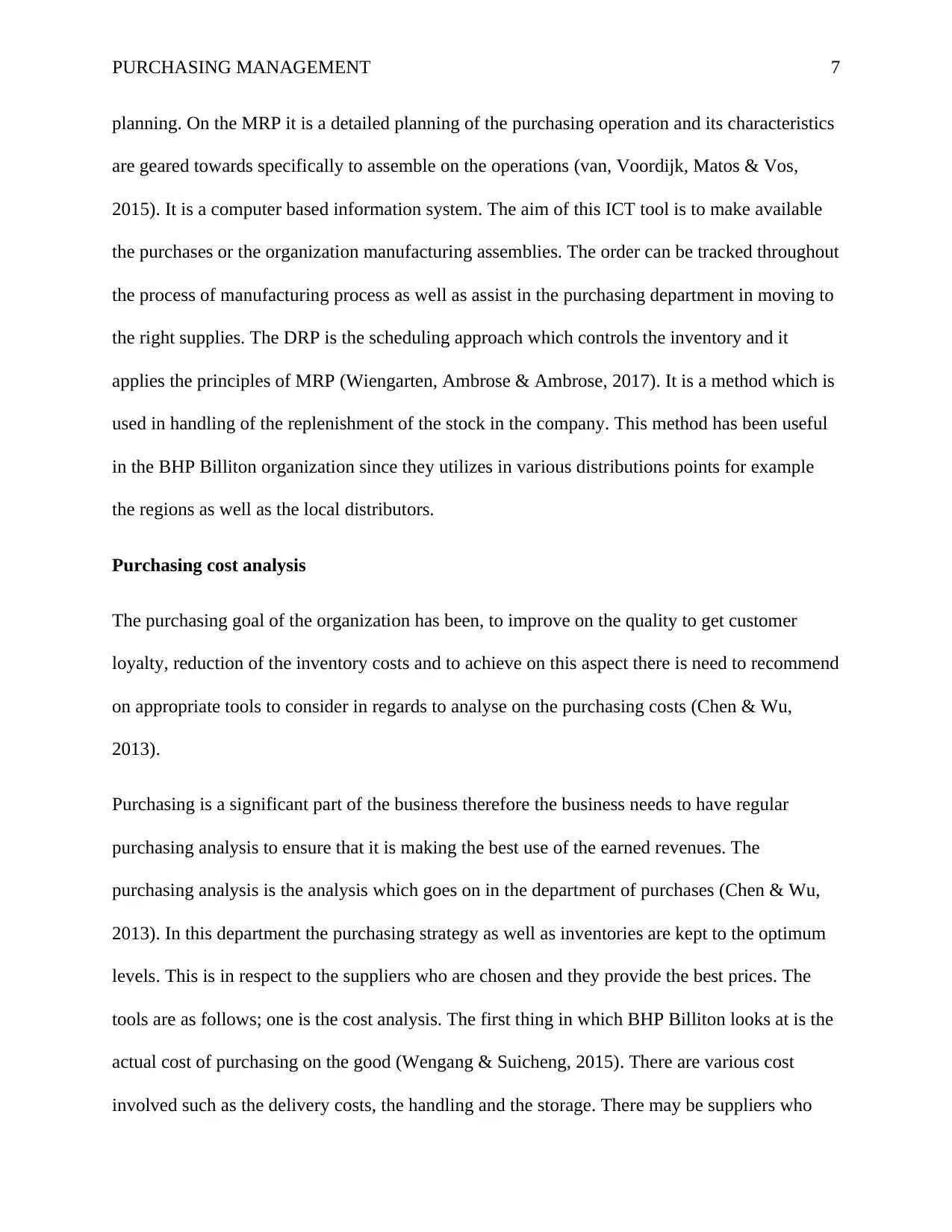
PURCHASING MANAGEMENT 7
planning. On the MRP it is a detailed planning of the purchasing operation and its characteristics
are geared towards specifically to assemble on the operations (van, Voordijk, Matos & Vos,
2015). It is a computer based information system. The aim of this ICT tool is to make available
the purchases or the organization manufacturing assemblies. The order can be tracked throughout
the process of manufacturing process as well as assist in the purchasing department in moving to
the right supplies. The DRP is the scheduling approach which controls the inventory and it
applies the principles of MRP (Wiengarten, Ambrose & Ambrose, 2017). It is a method which is
used in handling of the replenishment of the stock in the company. This method has been useful
in the BHP Billiton organization since they utilizes in various distributions points for example
the regions as well as the local distributors.
Purchasing cost analysis
The purchasing goal of the organization has been, to improve on the quality to get customer
loyalty, reduction of the inventory costs and to achieve on this aspect there is need to recommend
on appropriate tools to consider in regards to analyse on the purchasing costs (Chen & Wu,
2013).
Purchasing is a significant part of the business therefore the business needs to have regular
purchasing analysis to ensure that it is making the best use of the earned revenues. The
purchasing analysis is the analysis which goes on in the department of purchases (Chen & Wu,
2013). In this department the purchasing strategy as well as inventories are kept to the optimum
levels. This is in respect to the suppliers who are chosen and they provide the best prices. The
tools are as follows; one is the cost analysis. The first thing in which BHP Billiton looks at is the
actual cost of purchasing on the good (Wengang & Suicheng, 2015). There are various cost
involved such as the delivery costs, the handling and the storage. There may be suppliers who
planning. On the MRP it is a detailed planning of the purchasing operation and its characteristics
are geared towards specifically to assemble on the operations (van, Voordijk, Matos & Vos,
2015). It is a computer based information system. The aim of this ICT tool is to make available
the purchases or the organization manufacturing assemblies. The order can be tracked throughout
the process of manufacturing process as well as assist in the purchasing department in moving to
the right supplies. The DRP is the scheduling approach which controls the inventory and it
applies the principles of MRP (Wiengarten, Ambrose & Ambrose, 2017). It is a method which is
used in handling of the replenishment of the stock in the company. This method has been useful
in the BHP Billiton organization since they utilizes in various distributions points for example
the regions as well as the local distributors.
Purchasing cost analysis
The purchasing goal of the organization has been, to improve on the quality to get customer
loyalty, reduction of the inventory costs and to achieve on this aspect there is need to recommend
on appropriate tools to consider in regards to analyse on the purchasing costs (Chen & Wu,
2013).
Purchasing is a significant part of the business therefore the business needs to have regular
purchasing analysis to ensure that it is making the best use of the earned revenues. The
purchasing analysis is the analysis which goes on in the department of purchases (Chen & Wu,
2013). In this department the purchasing strategy as well as inventories are kept to the optimum
levels. This is in respect to the suppliers who are chosen and they provide the best prices. The
tools are as follows; one is the cost analysis. The first thing in which BHP Billiton looks at is the
actual cost of purchasing on the good (Wengang & Suicheng, 2015). There are various cost
involved such as the delivery costs, the handling and the storage. There may be suppliers who
Paraphrase This Document
Need a fresh take? Get an instant paraphrase of this document with our AI Paraphraser
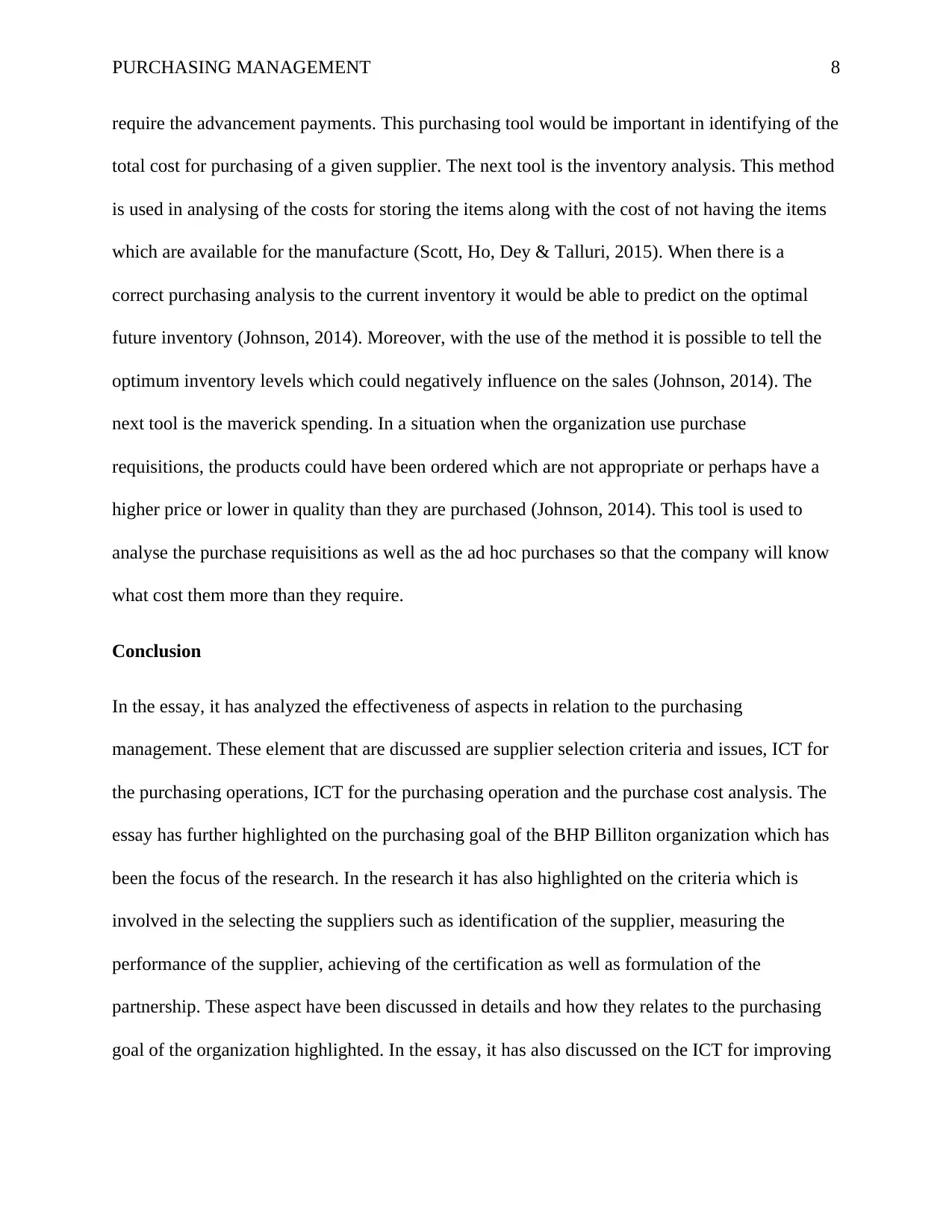
PURCHASING MANAGEMENT 8
require the advancement payments. This purchasing tool would be important in identifying of the
total cost for purchasing of a given supplier. The next tool is the inventory analysis. This method
is used in analysing of the costs for storing the items along with the cost of not having the items
which are available for the manufacture (Scott, Ho, Dey & Talluri, 2015). When there is a
correct purchasing analysis to the current inventory it would be able to predict on the optimal
future inventory (Johnson, 2014). Moreover, with the use of the method it is possible to tell the
optimum inventory levels which could negatively influence on the sales (Johnson, 2014). The
next tool is the maverick spending. In a situation when the organization use purchase
requisitions, the products could have been ordered which are not appropriate or perhaps have a
higher price or lower in quality than they are purchased (Johnson, 2014). This tool is used to
analyse the purchase requisitions as well as the ad hoc purchases so that the company will know
what cost them more than they require.
Conclusion
In the essay, it has analyzed the effectiveness of aspects in relation to the purchasing
management. These element that are discussed are supplier selection criteria and issues, ICT for
the purchasing operations, ICT for the purchasing operation and the purchase cost analysis. The
essay has further highlighted on the purchasing goal of the BHP Billiton organization which has
been the focus of the research. In the research it has also highlighted on the criteria which is
involved in the selecting the suppliers such as identification of the supplier, measuring the
performance of the supplier, achieving of the certification as well as formulation of the
partnership. These aspect have been discussed in details and how they relates to the purchasing
goal of the organization highlighted. In the essay, it has also discussed on the ICT for improving
require the advancement payments. This purchasing tool would be important in identifying of the
total cost for purchasing of a given supplier. The next tool is the inventory analysis. This method
is used in analysing of the costs for storing the items along with the cost of not having the items
which are available for the manufacture (Scott, Ho, Dey & Talluri, 2015). When there is a
correct purchasing analysis to the current inventory it would be able to predict on the optimal
future inventory (Johnson, 2014). Moreover, with the use of the method it is possible to tell the
optimum inventory levels which could negatively influence on the sales (Johnson, 2014). The
next tool is the maverick spending. In a situation when the organization use purchase
requisitions, the products could have been ordered which are not appropriate or perhaps have a
higher price or lower in quality than they are purchased (Johnson, 2014). This tool is used to
analyse the purchase requisitions as well as the ad hoc purchases so that the company will know
what cost them more than they require.
Conclusion
In the essay, it has analyzed the effectiveness of aspects in relation to the purchasing
management. These element that are discussed are supplier selection criteria and issues, ICT for
the purchasing operations, ICT for the purchasing operation and the purchase cost analysis. The
essay has further highlighted on the purchasing goal of the BHP Billiton organization which has
been the focus of the research. In the research it has also highlighted on the criteria which is
involved in the selecting the suppliers such as identification of the supplier, measuring the
performance of the supplier, achieving of the certification as well as formulation of the
partnership. These aspect have been discussed in details and how they relates to the purchasing
goal of the organization highlighted. In the essay, it has also discussed on the ICT for improving

PURCHASING MANAGEMENT 9
on the operations of purchases as well as the tools that are considered when analyzing on the
purchasing costs.
on the operations of purchases as well as the tools that are considered when analyzing on the
purchasing costs.
⊘ This is a preview!⊘
Do you want full access?
Subscribe today to unlock all pages.

Trusted by 1+ million students worldwide
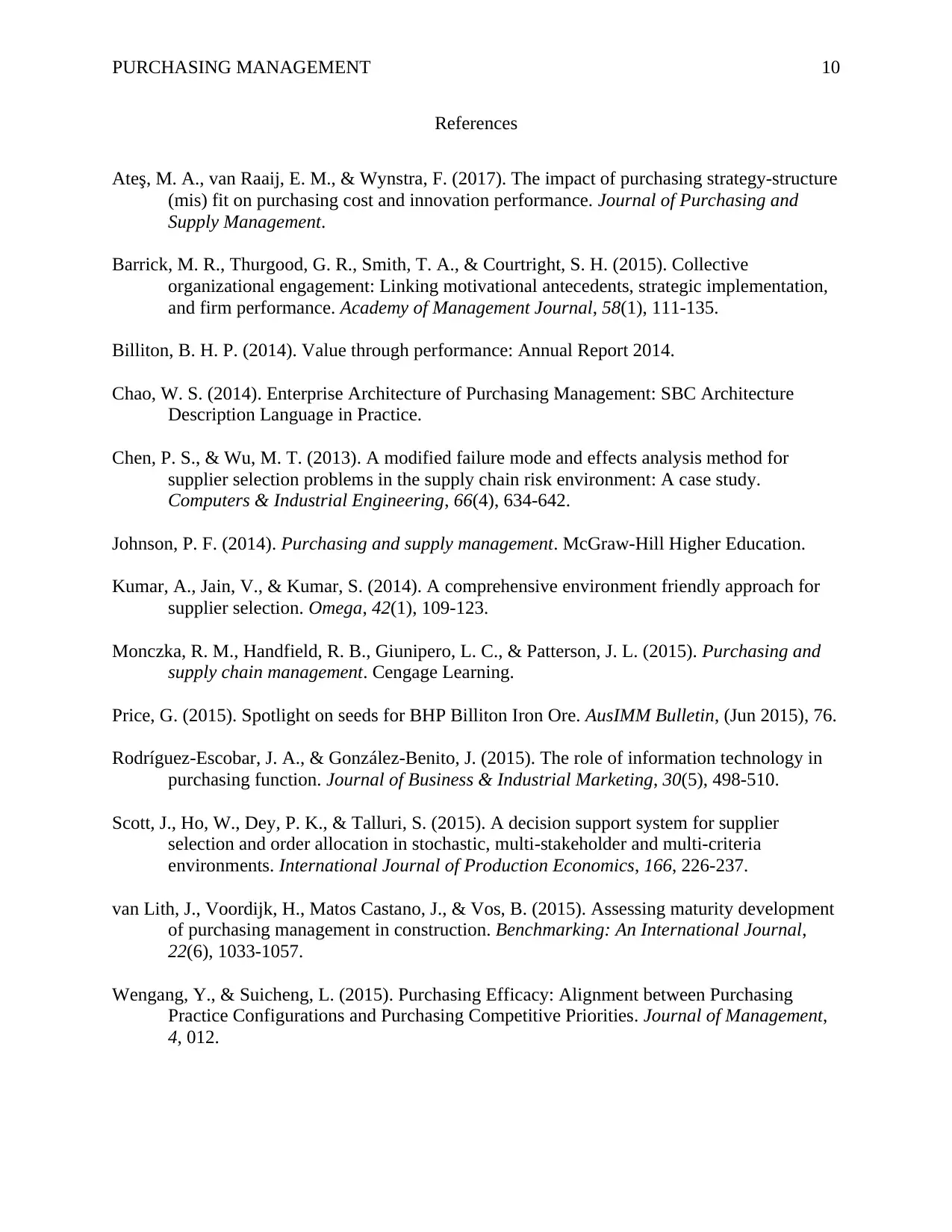
PURCHASING MANAGEMENT 10
References
Ateş, M. A., van Raaij, E. M., & Wynstra, F. (2017). The impact of purchasing strategy-structure
(mis) fit on purchasing cost and innovation performance. Journal of Purchasing and
Supply Management.
Barrick, M. R., Thurgood, G. R., Smith, T. A., & Courtright, S. H. (2015). Collective
organizational engagement: Linking motivational antecedents, strategic implementation,
and firm performance. Academy of Management Journal, 58(1), 111-135.
Billiton, B. H. P. (2014). Value through performance: Annual Report 2014.
Chao, W. S. (2014). Enterprise Architecture of Purchasing Management: SBC Architecture
Description Language in Practice.
Chen, P. S., & Wu, M. T. (2013). A modified failure mode and effects analysis method for
supplier selection problems in the supply chain risk environment: A case study.
Computers & Industrial Engineering, 66(4), 634-642.
Johnson, P. F. (2014). Purchasing and supply management. McGraw-Hill Higher Education.
Kumar, A., Jain, V., & Kumar, S. (2014). A comprehensive environment friendly approach for
supplier selection. Omega, 42(1), 109-123.
Monczka, R. M., Handfield, R. B., Giunipero, L. C., & Patterson, J. L. (2015). Purchasing and
supply chain management. Cengage Learning.
Price, G. (2015). Spotlight on seeds for BHP Billiton Iron Ore. AusIMM Bulletin, (Jun 2015), 76.
Rodríguez-Escobar, J. A., & González-Benito, J. (2015). The role of information technology in
purchasing function. Journal of Business & Industrial Marketing, 30(5), 498-510.
Scott, J., Ho, W., Dey, P. K., & Talluri, S. (2015). A decision support system for supplier
selection and order allocation in stochastic, multi-stakeholder and multi-criteria
environments. International Journal of Production Economics, 166, 226-237.
van Lith, J., Voordijk, H., Matos Castano, J., & Vos, B. (2015). Assessing maturity development
of purchasing management in construction. Benchmarking: An International Journal,
22(6), 1033-1057.
Wengang, Y., & Suicheng, L. (2015). Purchasing Efficacy: Alignment between Purchasing
Practice Configurations and Purchasing Competitive Priorities. Journal of Management,
4, 012.
References
Ateş, M. A., van Raaij, E. M., & Wynstra, F. (2017). The impact of purchasing strategy-structure
(mis) fit on purchasing cost and innovation performance. Journal of Purchasing and
Supply Management.
Barrick, M. R., Thurgood, G. R., Smith, T. A., & Courtright, S. H. (2015). Collective
organizational engagement: Linking motivational antecedents, strategic implementation,
and firm performance. Academy of Management Journal, 58(1), 111-135.
Billiton, B. H. P. (2014). Value through performance: Annual Report 2014.
Chao, W. S. (2014). Enterprise Architecture of Purchasing Management: SBC Architecture
Description Language in Practice.
Chen, P. S., & Wu, M. T. (2013). A modified failure mode and effects analysis method for
supplier selection problems in the supply chain risk environment: A case study.
Computers & Industrial Engineering, 66(4), 634-642.
Johnson, P. F. (2014). Purchasing and supply management. McGraw-Hill Higher Education.
Kumar, A., Jain, V., & Kumar, S. (2014). A comprehensive environment friendly approach for
supplier selection. Omega, 42(1), 109-123.
Monczka, R. M., Handfield, R. B., Giunipero, L. C., & Patterson, J. L. (2015). Purchasing and
supply chain management. Cengage Learning.
Price, G. (2015). Spotlight on seeds for BHP Billiton Iron Ore. AusIMM Bulletin, (Jun 2015), 76.
Rodríguez-Escobar, J. A., & González-Benito, J. (2015). The role of information technology in
purchasing function. Journal of Business & Industrial Marketing, 30(5), 498-510.
Scott, J., Ho, W., Dey, P. K., & Talluri, S. (2015). A decision support system for supplier
selection and order allocation in stochastic, multi-stakeholder and multi-criteria
environments. International Journal of Production Economics, 166, 226-237.
van Lith, J., Voordijk, H., Matos Castano, J., & Vos, B. (2015). Assessing maturity development
of purchasing management in construction. Benchmarking: An International Journal,
22(6), 1033-1057.
Wengang, Y., & Suicheng, L. (2015). Purchasing Efficacy: Alignment between Purchasing
Practice Configurations and Purchasing Competitive Priorities. Journal of Management,
4, 012.
Paraphrase This Document
Need a fresh take? Get an instant paraphrase of this document with our AI Paraphraser
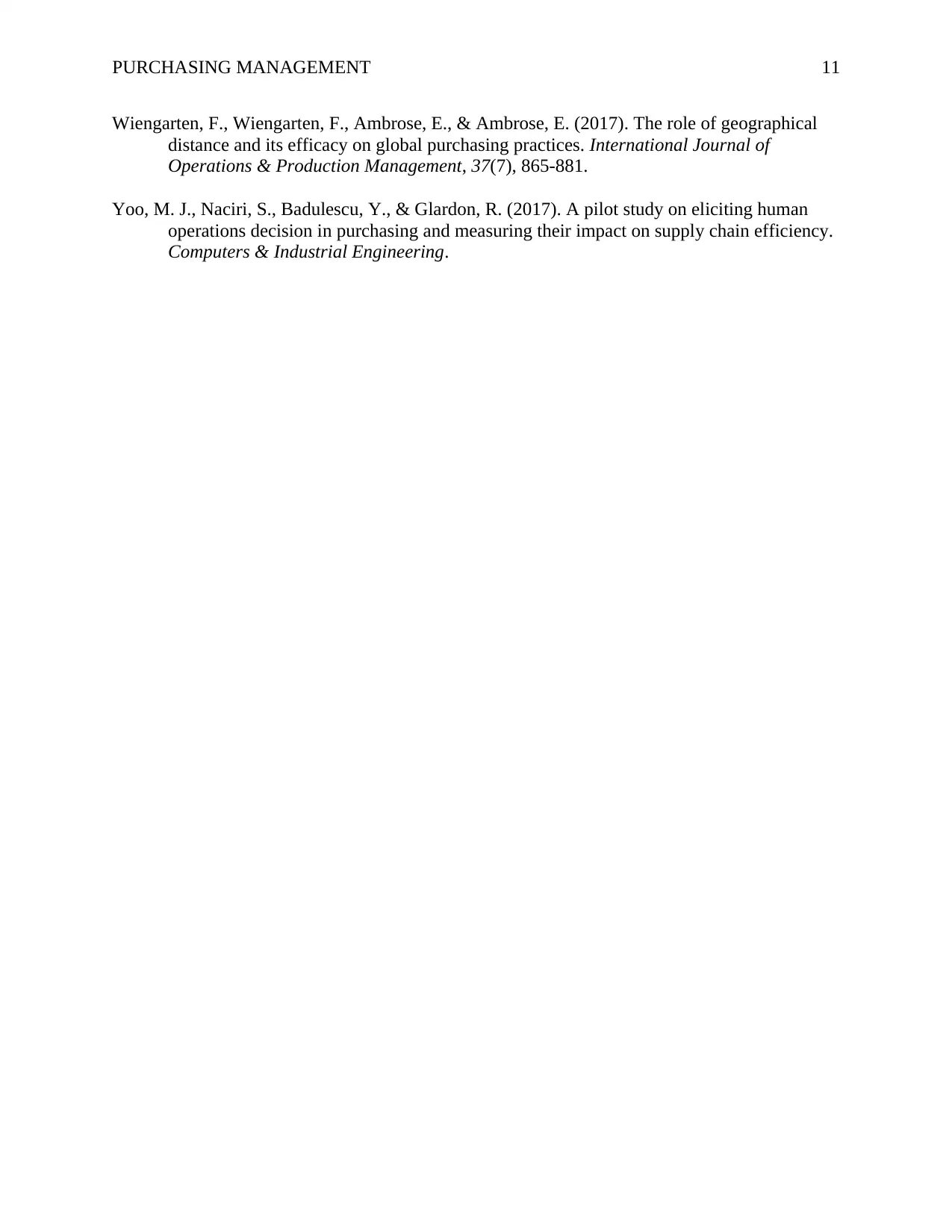
PURCHASING MANAGEMENT 11
Wiengarten, F., Wiengarten, F., Ambrose, E., & Ambrose, E. (2017). The role of geographical
distance and its efficacy on global purchasing practices. International Journal of
Operations & Production Management, 37(7), 865-881.
Yoo, M. J., Naciri, S., Badulescu, Y., & Glardon, R. (2017). A pilot study on eliciting human
operations decision in purchasing and measuring their impact on supply chain efficiency.
Computers & Industrial Engineering.
Wiengarten, F., Wiengarten, F., Ambrose, E., & Ambrose, E. (2017). The role of geographical
distance and its efficacy on global purchasing practices. International Journal of
Operations & Production Management, 37(7), 865-881.
Yoo, M. J., Naciri, S., Badulescu, Y., & Glardon, R. (2017). A pilot study on eliciting human
operations decision in purchasing and measuring their impact on supply chain efficiency.
Computers & Industrial Engineering.
1 out of 11
Related Documents
Your All-in-One AI-Powered Toolkit for Academic Success.
+13062052269
info@desklib.com
Available 24*7 on WhatsApp / Email
![[object Object]](/_next/static/media/star-bottom.7253800d.svg)
Unlock your academic potential
Copyright © 2020–2025 A2Z Services. All Rights Reserved. Developed and managed by ZUCOL.




